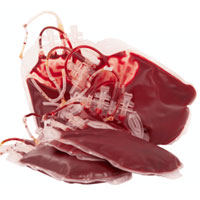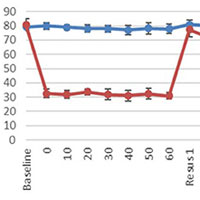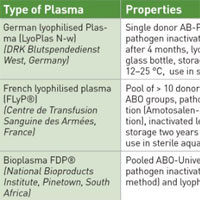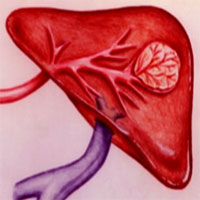Tag: hemorrhage

Prognostic Value of Spreading Depolarizations in Patients With Severe TBI
In this cohort study of patients with acute brain trauma, spreading depolarizations were predominant but heterogeneous and independently associated with poor neurologic recovery. Monitoring the occurrence of spreading depolarizations... read more

Quantitative EEG for Detection of Brain Ischemia
Electroencephalography (EEG) is a very promising tool for monitoring brain function in real-time in the ICU. There are characteristic changes that occur on EEG in response to brain ischemia, correlating with CBF and brain... read more

Vasopressin for Acute Hemorrhage?
Vasoactive medications are one of the pillars of management of shock in Emergency Departments. Inopressors, namely Norepinephrine and Epinephrine, are the two most commonly used pressors in US Emergency Departments, used... read more

Modeling Cardiac Dysfunction Following Traumatic Hemorrhage Injury
Cardiac dysfunction (CD) importantly contributes to mortality in trauma patients, who survive their initial injuries following successful hemostatic resuscitation. This poor outcome has been correlated with elevated biomarkers... read more

Hyperchloremia Is Associated With AKI in Patients With Subarachnoid Hemorrhage
Critically ill patients with subarachnoid hemorrhage show a strong association between hyperchloremia and acute kidney injury as well as acute kidney injury and mortality. Of 1,267 patients included in this cohort, 16.7%... read more

Use of Vasopressor Increases the Risk of Mortality in Traumatic Hemorrhagic Shock
Use of vasopressor for traumatic hemorrhagic shock was associated with mortality after controlling for biases (trauma severity; volume of fluid resuscitation). Among 236,698 trauma patients, 3,551 were included in the... read more

First Portable MRI Scanner for Neuro ICU
Health technology incubator Hyperfine Research and the Yale School of Medicine are testing out a first-of-its-kind, portable MRI scanner in the neuro intensive care unit (ICU). The point-of-care system, designed by Hyperfine,... read more

Reversal of Oral Anticoagulation in Patients with Acute Intracerebral Hemorrhage
In light of an aging population with increased cardiovascular comorbidity, the use of oral anticoagulation (OAC) is steadily expanding. A variety of pharmacological alternatives to vitamin K antagonists (VKA) have emerged... read more

Outcomes and Costs of Patients Admitted to the ICU Due to Spontaneous Intracranial Hemorrhage
Spontaneous intracranial hemorrhage, including subarachnoid hemorrhage and intracerebral hemorrhage, is associated with significant morbidity and mortality. Although many of these patients will require ICU admission, little... read more

Is Pre-hospital Coagulation Management in Trauma Feasible?
Coagulation management remains a formidable challenge in severely bleeding trauma patients. A strong rationale suggests starting treatment of trauma-induced coagulopathy in the pre-hospital phase. The burden of trauma is... read more

Catheter-Directed Therapy for PE Built on Fallacy
Tissue plasminogen activator has a notoriously checkered past within emergency medicine, and its controversial use continues with the advent of targeted therapy for pulmonary embolism. Catheter-directed administration of... read more

Mortality of civilian patients with suspected traumatic hemorrhage receiving pre-hospital transfusion of packed red blood cells compared to pre-hospital crystalloid
In a single centre UK HEMS study, in patients with suspected traumatic hemorrhage who received a PRBC transfusion there was an observed, but non-significant, reduction in mortality at 6 h and 28 days, also reflected in... read more

Blood test may obviate need for head CTs in brain trauma evaluation
A biomarker test based on the presence of two proteins in the blood appears to be suitable for ruling out significant intracranial injuries in patients with a history of mild traumatic brain injury (TBI) without the need... read more

The Contemporary Timing of Trauma Deaths
In this study, the distribution of trauma deaths no longer appears to be trimodal. This may reflect advances in trauma and ICU care, and the widespread adaption of damage control principles. Early deaths, however, remains... read more








